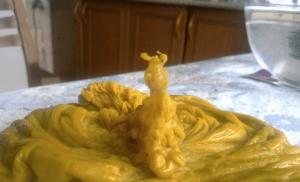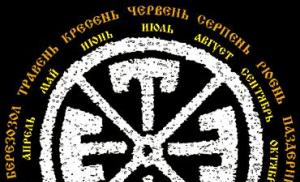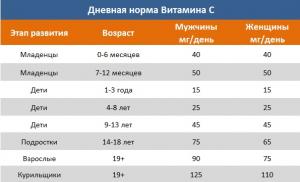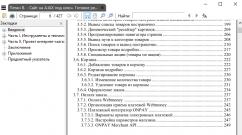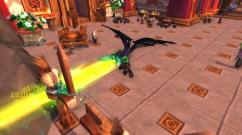How the web appears. Cobweb riddles
Spiders have numerous spider glands in their abdomen. Their ducts are opened by the smallest spinning tubes, which are found at the ends of six arachnoid warts on the abdomen of a spider. A spider-spider, for example, has about 500-550 such tubes. The spider's glands produce a liquid, viscous secretion made of protein. This secret has the ability to instantly harden in air. Therefore, when the protein secretion of the spider's glands is released through the spinning tubes, it solidifies in the form of thin filaments.
12
1. Spider-cross (with an opened abdominal cavity)
2. Spider web warts
The spider begins to spin its web like this: it presses the spider web warts to the substrate; at the same time, a small portion of the secreted secretion, solidifying, sticks to it. Then the spider continues to draw the viscous secretion from the cobweb tubes using its hind legs. When it is removed from the site of attachment, the rest of the secret is simply stretched into rapidly hardening threads.
Spiders use webs for a wide variety of needs. In a spider web shelter, the spider finds a favorable microclimate, where it also takes refuge from enemies and bad weather. Some spiders braid the walls of the mink with cobwebs. From the web, the spider weaves sticky trapping nets to catch prey. Egg cocoons, in which eggs and young spiders develop, are also made from cobwebs. The spider's web is also used for travel - from it small tarzans weave safety threads that protect them from falling when jumping. Depending on the purpose of use, the spider can produce sticky or dry thread of a certain thickness.
In terms of chemical composition and physical properties, the web is close to the silk of mulberry silkworms and caterpillars, only it is much stronger and more elastic: if the breaking load for caterpillar silk is 33-43 kg per 1 mm 2, then for a web - from 40 to 261 kg per mm 2 (depending on the type)!
Cobwebs can also be secreted by other arachnids, for example, spider mites and false scorpions. However, it was the spiders who achieved the true mastery of weaving the web. After all, it is important not only to be able to make a web, but also to produce it in large quantities. In addition, the “loom” should be located where it is more convenient to use. In false scorpions and spider mites, the raw material base of the web is located ... in the head, and the weaving apparatus is located on the oral appendages. Under the conditions of the struggle for existence, the advantage is gained by animals whose head is weighted down with brains, and not with cobwebs. This is what spiders are. The abdomen of a spider is a veritable spider web, and the spinning devices - spider warts - are formed from atrophied abdominal legs on the underside of the abdomen. And the limbs of spiders are simply "golden" - they spin so dexterously that any lace maker can envy them.
As a spider weaves a web, experts filmed a video where you can see in detail the actions of an arthropod. The ability to weave an openwork fabric, funnel-shaped nets, cocoons for larvae is transmitted genetically. The young spider repeats all the actions of its mother, never seeing how it is done. Spiders make cobwebs of different shapes, sizes, structures, and are used for different purposes.
Spider web composition
It is the secret of the spider's glands. After isolation, it stretches, hardens in the form of thin threads. In the future, they are intertwined, made stronger. Used to form a pattern or as a building material.
What the spider's web consists of is a protein enriched with alanine, serine, glycine. Inside the arachnoid gland, the substance is in liquid form. In the process of passing through the spinning tubes, it solidifies, turns into a thread.
Where does the spider's web come from - from the warts located near the genitals. A crystalline protein is formed inside the thread, which increases the strength and flexibility of the fibers. Depending on the purpose for which the web will be used, the thickness and strength change.
Interesting!
In terms of strength, the spider's web is close to nylon, retains tension when stretched, compressed. An object suspended on a long web can be rotated for a long time in one direction, it will not get tangled, it will not even offer resistance when moving. Thanks to this feature, the spider can hang in the air for a long time, attaching its end to the plant, and also for long distances using gusts of wind.
Why does a spider weave a web - basic functions
The web is allocated not arbitrarily, but when the need arises. Different people use threads for different purposes, but absolutely all females use a special secret to attract males.
- If you look closely at where the female releases the web from, you will notice that the warts with secretions are located near the genitals. A sexually mature female additionally releases odorous substances, the smell of which is captured by the male.
- The family weaves trapping nets. The creation of large specimens in a radius reaches 2 m. The density of the canvas is such that a bird, a small rodent, and amphibians get entangled in it. Insects and their larvae get entangled in the nets.
- Soil, underground specimens build burrows in the ground with numerous labyrinths. Trapping nets are not built, but they protect the entrance with cobwebs, pull the signal threads. By their vibration, they determine the approach of a potential victim, and immediately go hunting.
- Spiders live apart, gather in pairs only for mating. Possessions are divided, when borders are violated, deadly battles occur. For resettlement, the development of a new area, the spider weaves a strong long thread, attaches it to a leaf, twig, goes down, waits for a gust of wind. An arthropod can fly several hundred kilometers through the air, or it lands under a nearby bush. Active migration begins after the birth of the young generation of spiders.
- After fertilization, the female begins to form a cocoon from the web. Lays 50 to 1000 eggs inside. Fixes in a secluded place or drags along the entire period of development of the larvae.
- From strong threads, the arachnid builds a house for itself, a refuge for wintering. Unique creature -, builds a nest under water. Initially, it weaves a house of threads, fills it with air, lives inside, lets the male go into the mating season, incubates the cubs there, drags the caught prey inside.
- The predator envelops its prey with a web after injecting the toxin. After that, it leaves the prey, watches it aside, until the convulsions stop. If the predator is not hungry, it hangs the caught prey on a web in a secluded place in reserve.
- Some species of arthropods envelop the leaves with a cobweb, stretch a long thread, pull it to distract the attention of predators from their shelter. They make a puppet, which is then skillfully controlled. Some other craftsmen weave a raft from improvised means, swim on the surface of the water, catch fry, larvae, crustaceans.

The spider leaves trapping nets with significant damage to the threads by insects. Begins to form a new canvas after 12 caught victims.
On a note!
The arthropod often eats its invention. This phenomenon is explained by the replenishment of the body with protein, the presence of moisture, which accumulates on the canvas due to dew.
How a spider spins a web
Many arachnids are nocturnal, weaving in the dark. For how much a spider weaves a web, depends on the type of arthropod. On average, the orb weaving takes about 1 hour to form strong trapping nets. If renovation is required, the process takes a few minutes.
How quickly a spider weaves a web can be seen in the video below. The arthropod does this automatically, repeating the same pattern every time. The most attractive are openwork patterns in orb-webs. Initially, a strong web is taken, stretched in the shape of a triangle, then cells of different sizes are formed.
Interesting!
The cobweb found in the rainforests of Brazil is so durable that it is used by local fishermen to catch fish. A thin but very durable fabric is woven from threads. The Kraig Biocraft company makes body armor from natural raw materials of spiders.
How a spider weaves a web between trees can be seen in the garden, in the wild. An openwork fabric or a funnel sparkles in the sun and attracts insects. But the process itself, like a spider pulls a web between two trees, deserves admiration. Initially, the predator goes down, waits for a gust of wind, moves through the air to a nearby tree, fixes the second end there. Then little is left to do.
During flight, the spider controls its speed by adjusting the length of the filament. With lengthening, it moves more slowly, with contraction, it moves faster. To land, you need to throw the cobweb on a plant, tree.
Spiders are small weaving factories, they know how to produce fine threads, from which they skillfully weave lace. Experienced lace makers will envy their speed and skills. Where do spiders get their webs from?
If you turn the insect over and look closely, you will see bumps on the abdomen. These are arachnoid warts that evolved from atrophied hind legs. In the abdominal cavity of the spider there are numerous spider glands, the ducts of which open and close with tiny spinning tubes. Each species has a different number of them, some specimens have up to 500 of these tubes. This is a miniature "weaving factory". The glands tirelessly produce fluid. The viscous secretion consists of a protein that instantly hardens when it comes into contact with air. The liquid passes through thin tubes and, solidified, forms a cobweb.
The spider presses the arachnoid warts to the surface, a sticky secret flows out of them and sticks to it. Liquid continues to flow from the spider tubes. With the help of its hind legs, the spider stretches the liquid into a thin stream, which quickly hardens, forming a cobweb.
The cobweb is the finest thread ten times thinner than a human hair. It is highly durable and flexible. For example, a thread of natural silk is six times less durable than a spider's web.
The spider uses the web for a variety of purposes. Having carefully wrapped around the clutch of its eggs, the spider protects its future offspring from predators and drying out. For cocoons, the spider uses a special web that contains an antibiotic. It is he who protects the masonry from fungi and pathogenic bacteria.
Spider webs are a great hunting tool. Woven nets have a sticky middle. The insect, having got into the "snare", sticks, and desperately resisting, gets entangled. The spider calmly watches what is happening from the side. The spider recognizes that the nets have caught the "lunch" by the movements of the signal web, which he prudently brought directly to his hole. The spider eats the exhausted prey.
Trapping nets are an engineering marvel. The arachnids have thought through everything to the smallest detail. First, they weave a frame - longitudinal and transverse threads at a certain distance. The borders of the frame are attached to a fixed surface, it can be a tree, stone, wall, etc. The ray support threads are shaped like a snowflake. The insect weaves them from a non-sticky material, along which the spider will come to the caught prey.
The second stage of weaving trapping nets consists in laying spiral threads. For these purposes, spiders use sticky material; an unwary insect will stick to these threads. The coating loses its ability to adhere over time, so many spiders from time to time cover it with a fresh layer of "glue". To weave such a structure, the spider will spend the minimum amount of web and time.
The spiders braid the entrance to the hole with a thick layer of cobwebs. Firstly, it saves from bad weather, secondly, it protects from enemies, and thirdly, the desired microclimate is created inside the hole. If the insect is cold in its dwelling, it hangs "carpets" around the walls of the hole.
Spiders do not spend all their time in the burrow, sometimes they travel. Developing a cobweb, they descend along it, as if along a tightrope.
A spider would have a hard time living without a web. In order for the arachnids to survive, Mother Nature rewarded them with a gift - the ability to produce miracle threads. Insects use their skill everywhere and, in my opinion, do not complain about their life.
Despite all mankind's dislike for spiders, as well as the abundance of prejudices and scary stories associated with them, the question of how a spider weaves a web appears in babies almost simultaneously with interest, and the water is wet. The result of the labor of these unattractive animals really often resembles graceful lace. And if the spiders themselves are unpleasant to look at, and many are even afraid of them, then the web created by them involuntarily attracts attention and arouses sincere admiration.
Meanwhile, not everyone knows that such "curtains" are woven by not all representatives of the detachment. Almost every species is capable of creating a thread for the warp, but trapping nets weave only those that hunt with traps. They are called snare. They are even singled out as a separate superfamily "Araneoidea". And the names of spiders weaving hunting nets number as many as 2308 points, among which there are poisonous ones - the same and karakurt. Those who hunt, attacking from an ambush or tracking down prey, use the web exclusively for domestic purposes.
Unique qualities of spider "textiles"
Despite the small size of the creators, the features of the web cause some envy on the part of the crown of nature - man. Some of its parameters are incredible even with the achievements of modern science.
- Strength. The web can tear from its weight only if the spider spins it out 50 meters long.
- Exceptional subtlety. A separate cobweb is visible only when it hits a beam of light.
- Elasticity and resilience. The thread is stretched 2-4 times without breaking, and without loss of strength.
And all these qualities are achieved without any technical equipment - the spider does with what nature has provided him.

Types of cobwebs
It is interesting not only how the spider weaves a web, but also the fact that he manages to produce different "varieties" of it. Roughly speaking, they can be divided into three types:

Scientists also distinguish another type of web, which reflects ultraviolet light, beckoning butterflies. Many people believe that the finished web necessarily has its own pattern. However, this is not so: the names of spiders capable of creative delights can be counted without much difficulty, and all such artists belong to the araneomorphic representatives of this order of arthropods.
What is it for
If you ask a person why a spider needs a web, he will answer without any doubt: for hunting. But this does not at all exhaust its functions. Additionally, it is used in the following areas:
- for warming minks before wintering;
- to create cocoons in which offspring mature;
- for protection from rain - from it spiders make a kind of awnings that prevent water from entering the "house";
- for traveling. Some spiders move on their own and drive children out of the bosom of the family on long cobwebs carried away by the wind.
Building material formation
So, let's figure it out all the same, how a spider weaves a web. On the abdomen of the "weaver" there are six glands, which are considered transformed rudiments of the legs. A special secret is produced inside the calf, which is usually called liquid silk. At the exit through the spinning tubes, it begins to solidify. One such thread is so thin that it is difficult to see it even under a microscope. With its paws located closer to the glands "working" at the moment, the spider twists several threads into one cobweb - approximately the way women did in the old days when spinning from a tow. It is at that moment, as the spider weaves a web, that the main characteristic of the future cobweb is laid - stickiness or increased strength. And what is the selection mechanism, scientists have not yet figured out.

Stretching technology
The catching net for its effectiveness must be stretched between something - for example, between branches. When the first thread is created by its creator long enough, he stops spinning and spreads the spinning organs. So he catches the breeze. The slightest stirring of the wind (even from the heated earth) carries the cobweb to the neighboring "support", to which it clings. The spider moves along the "bridge" (most often sagging its back down) and starts weaving a new radial thread. Only when the base is fixed does it begin to move in a circle, weaving sticky transverse lines into it. I must say, spiders are very economical creatures. They eat up the damaged or old cobweb that turns out to be unnecessary, letting the "recyclable materials" go into the second round of use. And it becomes old, according to the creator, rather quickly, since the spider often weaves a web every day (or night, if he is a shadowhunter).

What spiders eat
A fundamentally important question, since the spider weaves a web, nevertheless, first of all for obtaining food. Note that all spider species, without exception, are predators. However, their diet is highly dependent on size, hunting methods and where they live. All snare (weaving webs) spiders are insectivorous, and their diet is mainly based on flying forms. Although if a crawling character falls from a tree onto the web, its owner will not disdain them. Those who live in burrows and closer to the ground eat mainly orthopterans and beetles, although they can drag a small snail or worm into their shelter. Among the variety of what spiders eat, there are also larger objects. For the aquatic representative of the tribe named Argyroneta, crustaceans, aquatic insects and fish fry become victims. Exotic tarantula giants hunt frogs, birds, small lizards and mice, although insects make up most of their diet. But there are also more finicky species. Individuals of the Mimetidae family hunt only non-species spiders. The huge tarantula Grammostola eats young snakes - and exterminates them in staggering quantities. Five families of spiders (in particular, Ancylometes) catch fish, moreover, they are able to dive, swim, track down prey and even haul it to land.
Indian summer is a great time for autumn, when you can soak up the last warm rays of the sun of the year, enjoy the excellent weather, and see the past summer. But, as usual, something must spoil the barrel of honey. Web. She is everywhere. It poisons my happiness, scares and spoils my mood. She pisses me off! The web rushes towards me in the most unexpected places, even where someone passed in front of me a minute ago, even where there is no vegetation nearby.
They also say that spider webs are incredibly strong and durable material. How does a spider weave a web that spreads it everywhere?
Algorithm for weaving a spider's web
I read it, it turns out creating spiderweb lace is a very time-consuming process for eight-legged creatures (spiders, by the way, cannot be called insects). They act like this:
- having chosen a suitable place, a special secret is isolated from the spider warts located on the abdomen, which, when frozen, converted into a long thinnest thread;
- waiting for the breeze will pick up this thread and will convey to any support - twigs, blades of grass, leaves, etc. and crawl to the place where the thread caught, securely fix it;
- form another thread repeating the first, fix it;
- crawl to the middle of the second thread and form a third thread, placing it perpendicular to the first two, and fix it so that a shape resembling the letter Y is formed.

This is the basis of the future web. Then the spider stretches several more radii from the point of intersection of the threads, connecting their ends with thread segments. It turns out the skeleton of a web, peculiar ribs with edging. Further, fluttering over this blank, the spider quickly knits a lace pattern on it.
The patterns are created using two spirals. The first, not sticky, spider weaves from the middle of the base, and it exactly repeats the shape of the logarithmic spiral; the second, sticky, weaves in the opposite direction and exactly repeats the shape of the Archimedean spiral.
Types of spider webs
There are 35 thousand species of spiders on the planet. Not all eight-legged creatures weave tight webs.

Some representatives weave a tiny net of cobwebs between their paws, wait for prey and throw a prepared sticky net on top of it. And there are representatives who do not bother with weaving at all. They catch the victim on homemade spider thread lasso with a droplet of sticky substance at the end. There are species that work together entwining huge areas with cobwebs.
What is the web used for
The most common web function is catching a victim for food. But this is far from its only purpose.

They also use the web:
- to protect the home;
- as home decoration;
- for cocoons in which females lay eggs;
- as a means of transportation.
It is the last point that explains the fact of the autumn invasion of the flying web. So young spiders settle in the area.
Appearance
In general, female goliath tarantulas are usually larger than males. The size of their soft body reaches 9 cm, while in males it is no more than 8 cm. The leg span of these giant spiders ranges from 25 cm to 28 cm. The largest individuals weigh about 150 grams.
The protective color of tarantulas varies from black to yellow-orange. This usually happens just before molting. The cephalothorax of these creatures, as well as their abdomen, are covered with short, but dense hairs. The paws are covered with long and reddish hairs.
Where does the world's largest spider live?
The favorite places of these creatures are mountainous regions with dense and humid forests. The optimal habitat for these "giants" is humid and swampy areas, mainly located in the Venezuelan rainforests. In addition, goliath tarantulas are widespread in the rainforests of Guyana, Suriname and Brazil.
Goliath tarantulas inhabit whole burrows up to 1 m deep. Outside, they braid them with thick cobwebs to prevent strangers from getting inside. It is females that spend most of their lives in burrows. They go hunting only at night. And this despite their impaired vision.
Hunting
The goliath tarantula is a carnivorous spider. Before attacking a potential victim, this creature lurks in an impromptu ambush. So the spider lies in wait for its "supper". As soon as the future prey has approached a sufficient distance for attack, the tarantula pounces on it, using its fangs.
Contrary to its name, the tarantula does not eat birds at all. This was apparently an isolated incident. The fact is that this species of spider from the order of arachnids was first noticed exactly when, for some reason, it ate a bird. Zoologists, who have been observing goliaths for a long time, came to the conclusion that the favorite and main food of these creatures is both invertebrates (butterflies, beetles) and vertebrates (mice, small snakes, frogs).
Life span
In general, zoologists call individuals that have reached the age of three as adult tarantulas. The average life span of a male goliath is 6 years. The female lives twice as long - up to 14 years. It is curious that often the life of males ends after they mate with a female.
The fact is that during mating games, goliath tarantulas, like praying mantises, have a ritual: after mating, the female simply eats her “groom” without his consent. However, not all spider suitors want to put up with this state of affairs. That is why nature has awarded them with sharp thorns located on the first pair of limbs. They serve as protection against aggressive females.
What it consists of and where it is formed
The web contains the following substances:
- organic compounds- protein fibroin, of which the main inner thread is composed, and glycoproteins, which form nanofibers located around the main thread. Thanks to fibroin, the web is similar in composition to silk, but much more elastic and stronger;
- inorganic substances- chemical compounds of potassium (hydrogen phosphate and nitrate). Their number is small, but they give the cobweb antiseptic properties and protect it from fungi and bacteria, create a favorable environment in the spider's glands for the formation of filaments.
In the abdomen of the spider there are spider glands, where a liquid substance is formed, which exits through the spinning tubes located on the arachnoid warts. They can be seen at the very bottom of the abdomen.  A viscous liquid comes out of the tube and quickly hardens in air. With the help of its hind legs, the spider draws the thread and uses it for weaving. One spider is capable of producing a thread of 0.5 km in length.
A viscous liquid comes out of the tube and quickly hardens in air. With the help of its hind legs, the spider draws the thread and uses it for weaving. One spider is capable of producing a thread of 0.5 km in length.
What are the types
Spiders, depending on the species, can weave different webs.
The form can be as follows:

How and how long do spiders weave a web
The spider weaves the most famous round net for 0.5–3 hours. The length of the weave depends on the size of the mesh and the weather. In this case, the wind usually becomes the best helper, carrying the thread released by the spider over decent distances.
It is downwind that the cobweb stretched between the trees is located. A thin thread is carried by the air stream, clings to a neighboring tree and perfectly withstands the movement of its creator.
He periodically refreshes the braided net, as over time it loses the ability to hold prey.
The spider usually eats old cobwebs to provide itself with the building materials needed to weave a new product. Automatic actions to build a network are genetic and are inherited. 
Properties and functions
The spider web has the following properties:
- Very durable... Due to its special structure, its strength is comparable to nylon, it is several times stronger than steel.
- Internal hinge... An object suspended on a spider's thread can be rotated in one direction as long as you like without twisting.
- Very thin... The spider thread is extremely thin compared to the threads of other living things. In many families of spiders, it is 2-3 microns. For comparison, the thickness of the silkworm thread is in the range of 14-26 microns.
- Adhesion... The threads themselves are not sticky, they are dotted with droplets of sticky liquid. However, a spider for creating a web produces not only a sticky thread, but also a thread devoid of glue particles.
The spider's web is essential for the life of the spider.  It performs the following functions:
It performs the following functions:
- Asylum. The woven web serves as a good shelter from bad weather, as well as from enemies in the natural environment.
- Creation of a favorable microclimate. For example, in water spiders, it is filled with air and allows them to be under water. They also use it to close the shells in which they live at the bottom.
- Trap for food objects. The spider is carnivorous, and its diet consists of insects entangled in a sticky web.
- Material for creating a cocoon from which new spiders emerge.
- A device that plays a role in the reproduction process. During the mating season, females weave a long thread and leave it hanging so that a male passing by can easily reach them.
- Deception of predators. Some orb-web spiders use it to glue the debris and make dummies to which the thread is attached. In case of danger, they pull the thread and distract attention from themselves with a moving dummy.
- Insurance. Before attacking a victim, spiders attach a spider's thread to some object and jump on prey, using the thread as a safety net.
- Vehicle. Young spiders use a long thread to leave their “father’s house”. Spiders living in reservoirs use spider weaving as a water transport.

How a person can use the web
In China, of amazing strength and lightness, the spider web is called "the fabric of the eastern sea". The Polynesians use the cobweb threads of large snake spiders for sewing, and besides this, they also weave nets from them for catching fish.
Scientists from Japan were able to create violin strings from spider silk. Nowadays, scientists are striving to synthesize a material with the properties of a spider web for use in various fields - from the production of body armor to the construction of bridges.
But science is not yet capable of creating an analogue of the substance that the spider produces. To do this, some researchers are trying to introduce spider genes into other living organisms.
Biologist from Holland Abdul Wahab El-Khalbzuri and artist Jalil Essaydi through research activities synthesized super-durable tissue, which is an organic combination of spider web and human skin.
 Until then, DuPont Kevlar fibers were considered the strongest fabric, which is 5 times stronger than steel - and the material obtained using spider threads is 15 times stronger than steel. But such a synthetic substance has a number of disadvantages that scientists are still working on.
Until then, DuPont Kevlar fibers were considered the strongest fabric, which is 5 times stronger than steel - and the material obtained using spider threads is 15 times stronger than steel. But such a synthetic substance has a number of disadvantages that scientists are still working on. The web is remarkable not only for its durability. The antibacterial properties of such a spider product have been used for a long time. Even in ancient times, people used a spider web as a bandage.
This sticky material adhered to the skin and created a barrier for bacteria and viruses to enter the wound. Many research institutions are working with spider webs, trying to apply its properties in medicine to create a material that can regenerate limbs.
Scientists in Europe claim that within 5 years they will be able to synthesize artificial tendons and ligaments from spider webs.
In the modern world, cobweb threads are used in the optical industry to denote crosshairs in optical devices, as well as threads in microsurgery. It is also known that microbiologists have created an air analyzer using the properties of spider filaments to capture microparticles from the surrounding traces.  It should be noted that the study of the properties of the web will allow in the future to achieve great results in many industries, as well as contribute to the development and emergence of advanced technologies that are important for humanity.
It should be noted that the study of the properties of the web will allow in the future to achieve great results in many industries, as well as contribute to the development and emergence of advanced technologies that are important for humanity.
Why does a spider not stick to its web
When hunting for its prey (flies, midges and other insects), which get entangled in sticky nets, the spider itself does not stick to its own trap.
Consider the factors that prevent the spider from sticking to its product:
- Not all spider webs are covered with glue, but only some areas that are well known to its creator. It is the circular threads that are sticky, and the central threads are not impregnated with an adhesive substance.
- The legs of the spider are completely covered with short and fine hairs. These hairs quickly remove droplets of glue invisible to the eye from the threads of the cobweb. When the foot is in the area of the spider web, particles of glue are on the hairs. When the spider removes the foot from the area without glue, the hairs, when sliding against the thread, return the glue particles back.
- The special substance that coats the spider's legs reduces the level of interaction with the glue, which additionally helps against adhesion.
Video: about the web of spiders So, the spider's web is synthesized in the spider's glands located on the abdomen of spiders, and has a predominantly protein composition. These arthropods weave it for different needs, and it comes in many different shapes. Moreover, it has extraordinary properties that humanity can use for its own purposes. Scientists from different countries are trying to synthesize a substance similar to her.

